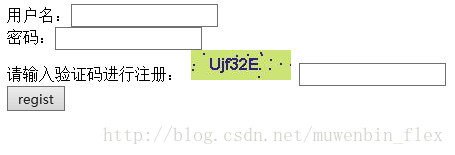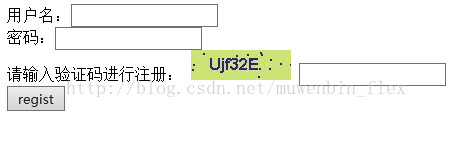一 验证码的由来
在web项目开发中,为了防止部分人使用自动工具(如:自动注册机)等进行批量的数据处理,在不同的功能节点部分,添加了验证码进行验证,达到对自动软件的屏蔽效果
最经典的应用如:网站注册图形验证码;接下来,通过java技术,结合servlet实现一个网站注册需要的图形验证码程序,提供大家参考。
二 实现注册页面图形验证码效果
1. 创建web项目:java_servlet_verifyimg
2. 创建自动生成图形验证码的控制器——VerifyImgServlet
package com.phome.util;
import java.awt.Color;
import java.awt.Font;
import java.awt.Graphics2D;
import java.awt.image.BufferedImage;
import java.io.IOException;
import java.util.Random;
import javax.servlet.ServletException;
import javax.servlet.ServletOutputStream;
import javax.servlet.http.HttpServlet;
import javax.servlet.http.HttpServletRequest;
import javax.servlet.http.HttpServletResponse;
import com.sun.image.codec.jpeg.JPEGCodec;
import com.sun.image.codec.jpeg.JPEGImageEncoder;
public class VerifyImgServlet extends HttpServlet {
/**
*
*/
private static final long serialVersionUID = 1L;
// 设置随机字符字典。其中不包含0,o,1,I等难以辨认的字符
public static final char[] CHARS = { '2', '3', '4', '5', '6', '7', '8',
'9', 'A', 'B', 'C', 'D', 'E', 'F', 'G', 'H', 'J', 'K', 'L', 'M',
'N', 'P', 'Q', 'R', 'S', 'T', 'U', 'V', 'W', 'X', 'Y', 'Z', 'a',
'b', 'c', 'd', 'e', 'f', 'g', 'h', 'j', 'k', 'l', 'm', 'n', 'p',
'q', 'r', 's', 't', 'u', 'v', 'w', 'x', 'y', 'z' };
public static Random random = new Random(); // 随机数对象
public static String getRandomString() {
StringBuffer buffer = new StringBuffer(); // 字符串缓存
for (int i = 0; i < 6; i++) // 六次循环获取字符
{
buffer.append(CHARS[random.nextInt(CHARS.length)]); // 每次随机取一个字符
}
return buffer.toString();
}
public static Color getRandomColor() {
return new Color(random.nextInt(255), random.nextInt(255),
random.nextInt(255));
}
public static Color getReverseColor(Color c) {
return new Color(255 - c.getRed(), 255 - c.getGreen(),
255 - c.getBlue());
}
public void doGet(HttpServletRequest request, HttpServletResponse response)
throws ServletException, IOException {
response.setContentType("image/jpeg"); // 设置输出类型 不可省略
String randomString = getRandomString(); // 调用生成随机字符串方法获取并接受随机字符串
request.getSession(true).setAttribute("randomString", randomString); // 将字符串存储到Session中
int width = 100; // 图片宽度
int height = 30; // 图片高度
Color color = getRandomColor(); // 获取随机颜色 用于背景色
Color reverse = getReverseColor(color); // 反色 用于前景色
BufferedImage bi = new BufferedImage(width, height,
BufferedImage.TYPE_INT_RGB); // 创建一个彩色图片
Graphics2D g = bi.createGraphics(); // 获取绘图对象
g.setFont(new Font(Font.SANS_SERIF, Font.BOLD, 16)); // 设置字体
g.setColor(color); // 设置颜色
g.fillRect(0, 0, width, height); // 绘制背景
g.setColor(reverse); // 设置颜色
g.drawString(randomString, 18, 20); // 绘制随机字符
for (int i = 0, n = random.nextInt(100); i < n; i++) // 画最多一百个噪音点
{
g.drawRect(random.nextInt(width), random.nextInt(height), 1, 1); // 随机噪音点
}
ServletOutputStream out = response.getOutputStream(); // 好像是获取输出流
JPEGImageEncoder encoder = JPEGCodec.createJPEGEncoder(out); // 编码器
encoder.encode(bi); // 对图片进行编码
out.flush(); // 输出到客户端
}
public void doPost(HttpServletRequest request, HttpServletResponse response)
throws ServletException, IOException {
this.doGet(request, response);
}
}
3. 创建注册控制器——RegistServlet
package com.phome.servlet;
import java.io.IOException;
import javax.servlet.ServletException;
import javax.servlet.http.HttpServlet;
import javax.servlet.http.HttpServletRequest;
import javax.servlet.http.HttpServletResponse;
import javax.servlet.http.HttpSession;
/**
* 注册控制器
* @author ZuoYi
*
*/
public class RegistServlet extends HttpServlet{
/**
*
*/
private static final long serialVersionUID = 1L;
@Override
protected void doGet(HttpServletRequest req, HttpServletResponse resp)
throws ServletException, IOException {
this.doPost(req, resp);
}
@Override
protected void doPost(HttpServletRequest req, HttpServletResponse resp)
throws ServletException, IOException {
// 从session中获取注册随机验证码
HttpSession session = req.getSession();
String randomString = (String)session.getAttribute("randomString");
// 获取用户输入验证码
String inputRandomString = req.getParameter("randomStr");
// 判断验证码通过,模拟进行注册
if (randomString.equals(inputRandomString)) {
req.setAttribute("resinfo", "恭喜!注册成功!");
} else {
req.setAttribute("resinfo", "验证码输入有误,请检查后重新进行注册!");
}
// 注册成功或者失败,都跳转到result.jsp页面,查看注册结果。。。
req.getRequestDispatcher("result.jsp").forward(req, resp);
}
}
4. 配置servlet
<?xml version="1.0" encoding="UTF-8"?>
<web-app xmlns:xsi="http://www.w3.org/2001/XMLSchema-instance" xmlns="http://java.sun.com/xml/ns/javaee" xsi:schemaLocation="http://java.sun.com/xml/ns/javaee http://java.sun.com/xml/ns/javaee/web-app_3_0.xsd" id="WebApp_ID" version="3.0">
<display-name>simg</display-name>
<!-- 配置用户注册servlet -->
<servlet>
<servlet-name>registservlet</servlet-name>
<servlet-class>com.phome.servlet.RegistServlet</servlet-class>
</servlet>
<servlet-mapping>
<servlet-name>registservlet</servlet-name>
<url-pattern>/regist.action</url-pattern>
</servlet-mapping>
<!-- 配置图形验证码servlet -->
<servlet>
<servlet-name>verifyimg</servlet-name>
<servlet-class>com.phome.servlet.VerifyImgServlet</servlet-class>
</servlet>
<servlet-mapping>
<servlet-name>verifyimg</servlet-name>
<url-pattern>/verifyimg.action</url-pattern>
</servlet-mapping>
<welcome-file-list>
<welcome-file>index.html</welcome-file>
<welcome-file>index.htm</welcome-file>
<welcome-file>index.jsp</welcome-file>
<welcome-file>default.html</welcome-file>
<welcome-file>default.htm</welcome-file>
<welcome-file>default.jsp</welcome-file>
</welcome-file-list>
</web-app>
5. 创建注册视图测试页面——regist.jsp
<%@ page language="java" import="java.util.*" pageEncoding="GB18030"%>
<%
String path = request.getContextPath();
String basePath = request.getScheme()+"://"+request.getServerName()+":"+request.getServerPort()+path+"/";
%>
<!DOCTYPE HTML PUBLIC "-//W3C//DTD HTML 4.01 Transitional//EN">
<html>
<head>
<base href="<%=basePath%>" rel="external nofollow" rel="external nofollow" >
<title>My JSP 'index.jsp' starting page</title>
<meta http-equiv="pragma" content="no-cache">
<meta http-equiv="cache-control" content="no-cache">
<meta http-equiv="expires" content="0">
<meta http-equiv="keywords" content="keyword1,keyword2,keyword3">
<meta http-equiv="description" content="This is my page">
<!--
<link rel="stylesheet" type="text/css" href="styles.css" rel="external nofollow" rel="external nofollow" >
-->
</head>
<body>
<form action="${pageContext.request.contextPath}/regist.action" method="post">
用户名:<input type="text" name="username"/>
<br />
密码:<input type="text" name="password"/>
<br />
请输入验证码进行注册:
<img src="${pageContext.request.contextPath }/verifyimg.action"/>
<input type="text" name="randomStr"/>
<br />
<input type="submit" value="regist"/>
</form>
</body>
</html>
5.1 创建注册结果页面——result.jsp
<%@ page language="java" import="java.util.*" pageEncoding="GB18030"%>
<%
String path = request.getContextPath();
String basePath = request.getScheme()+"://"+request.getServerName()+":"+request.getServerPort()+path+"/";
%>
<!DOCTYPE HTML PUBLIC "-//W3C//DTD HTML 4.01 Transitional//EN">
<html>
<head>
<base href="<%=basePath%>" rel="external nofollow" rel="external nofollow" >
<title>My JSP 'index.jsp' starting page</title>
<meta http-equiv="pragma" content="no-cache">
<meta http-equiv="cache-control" content="no-cache">
<meta http-equiv="expires" content="0">
<meta http-equiv="keywords" content="keyword1,keyword2,keyword3">
<meta http-equiv="description" content="This is my page">
<!--
<link rel="stylesheet" type="text/css" href="styles.css" rel="external nofollow" rel="external nofollow" >
-->
</head>
<body>
${requestScope.resinfo }
</body>
</html>
6.测试
(1)a.打开浏览器,输入测试地址:http://localhost:8080/java_servlet_verifyimg;出现如下图所示页面

b.输入注册账号、密码和验证码后点击regist提交

c.测试结果,跳转会注册页面,提示注册成功

(2)打开注册页面

输入错误注册码

测试结果页面

over!
更多关于验证码的文章请点击查看:《java验证码》
以上就是本文的全部内容,希望对大家的学习有所帮助,也希望大家多多支持亿速云。
亿速云「云服务器」,即开即用、新一代英特尔至强铂金CPU、三副本存储NVMe SSD云盘,价格低至29元/月。点击查看>>
免责声明:本站发布的内容(图片、视频和文字)以原创、转载和分享为主,文章观点不代表本网站立场,如果涉及侵权请联系站长邮箱:is@yisu.com进行举报,并提供相关证据,一经查实,将立刻删除涉嫌侵权内容。